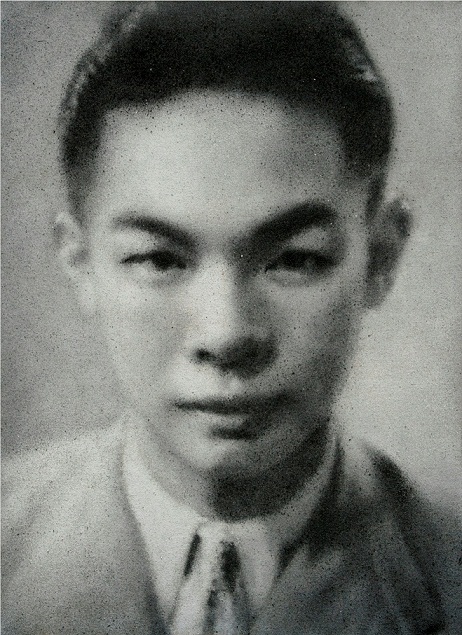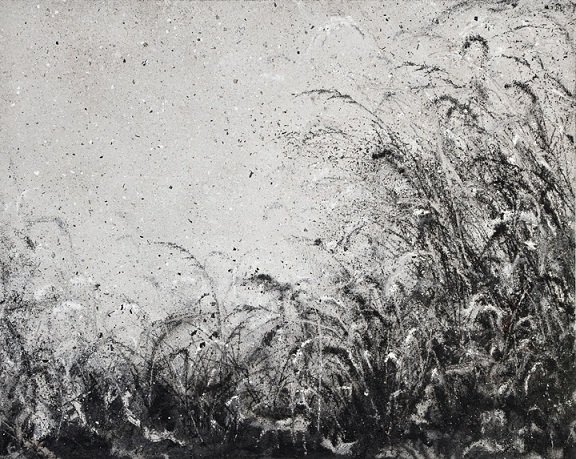Reviews & Articles
Zhang Huan: Aura of Disappearance and Three Heads Six Arms
Hilary BINKS
at 11:15pm on 9th June 2011





Captions:
1. Zhang Huan. Three Heads Six Arms. 2008. Copper. 800 x 1,800 x 1,000 cm.
2. Zhang Huan. Shanghai Bridegroom. 2008. Ash on linen. 150 x 110 cm.
3. Zhang Huan. Spring. 2008. Ash on linen. 250 x 200 cm. (c) Zhang Huan Studio. Courtesy The Pace Gallery.
4. Zhang Huan. Grass No. 3. 2010. Ash on linen. 200 x 250 cm. (c) Zhang Huan Studio. Courtesy The Pace Gallery.
5. Zhang Huan. National Day 1984, No.1. 2010. Ash on linen. 250 x 400 cm. (c) Zhang Huan Studio. Courtesy The Pace Gallery.
(原文以英文發表,評論張洹在馬淩畫廊的展覽《張洹:消失的氛圍》,以及在香港尖沙咀1881廣場的戶外雕塑作品《三頭六臂》。)
Chinese contemporary art seems to need its stars, and since senior rebels like Wang Guangyi and Zhang Xiaogang have become establishment figures, the idol of the moment is Zhang Huan. The former angry young man, who once sat in a public toilet covered with fish oil letting flies swarm over him, is now a self-assured artist fêted worldwide. It was therefore a coup for Edouard Malingue, who opened his gallery in Hong Kong in September 2010 focusing on Impressionism and Modern Art, to stage Zhang Huan’s first solo exhibition in Hong Kong.
Zhang Huan is one of China’s most renowned performance and conceptual artists. Born in 1965 in Anyang, Henan Province, he studied painting at Henan University and earned an MA from the Central Academy of Fine Arts in Beijing, but switched to performance art, which he found a more powerful means of expression. From the start his often traumatic performances always involved his own body as an artistic medium.
In the early part of his career, Zhang Huan became famous through the photographic documentation of his performance works such as 12 Square Metres (mentioned above) which was interpreted as an indictment of the appalling living conditions in Beijing East Village, the artistic community where he lived, and the ability of the mind to rise above pain. He also choreographed group performances, such as To Raise the Water Level in a Fishpond, in which he asked 40 migrant workers to stand in a pond; and To Add One Meter to an Anonymous Mountain, where he and 9 other artists climbed a mountain near Beijing, stripped naked and lay on top of one another. In 1998, Zhang moved to New York and created further performance works which often expressed his feelings of alienation in a foreign culture.
The current exhibition focuses on works from the second phase of Zhang’s career - the ash paintings and sculptures which he began making after he returned to China in 2005, converted to Buddhism, and set up his studio in Shanghai. Zhang chose to work with incense ash as a medium because of its associations with Buddhist religious practice. He collected the ash from temples near Shanghai. For him ash was more than just any artistic medium: “[Ash] represents the collective souls, memories and prayers of the faithful. The prayers offered are all devout and beautiful. Those faithful people go to temples praying for a child, for peace in their homes, for recovering from illness, for prosperity in the coming year, for success at work, and so on.” For Zhang, the ash thus has a spiritual power which can manifest itself via his paintings.
Zhang’s ash paintings are based on old black and white photos from magazines such as the PLA Pictorial or National Pictorial, dating from the early years of the Republic in the 1940s and the latter years of the Cultural Revolution in the 1970s. Paradoxically Zhang uses the radical new medium of ash, which is also redolent of thousands of years of China’s tradition and cultural history, to resurrect and transcend the past in China. As in his earlier performance works, Zhang’s intention is catharsis, a liberation from pain through art. The works indeed seem to exert a magnetic draw on the viewer; the large portraits especially have a haunting resonance, seeming to conjure up spirits of the past.
At the same time, Zhang Huan’s monumental copper sculpture Three Heads Six Arms is on display at the Grand Piazza of 1881 Heritage in Tsim Sha Tsui. Measuring 800 x 1,800 x 1,000 cm, this is the largest of a series of works inspired by fragments of Buddhist statues which Zhang Huan found in a market shortly after his return to China. Troubled by their destruction, he started making large-scale copper hands based on the symbolic fingers of Buddhist deities. He then created works combining the legs, feet, hands and heads of Buddha figures in an attempt to reverse and atone for the desecration they had suffered.
Three Heads Six Arms is based on the Chinese mythological figure Nezha and Tibetan Buddhist sculptures. Two of the three Buddha heads have been replaced by human heads, including a self-portrait of the artist. As in his earlier performance pieces, Zhang places himself centre stage, apparently to emphasize the importance of liberation through experience. Impressive in scale, the work combines a mixture of Buddhist serenity and the fierceness of Tibetan iconography. Hints of Zhang Huan’s early fieriness remain too. The sculpture met with critical acclaim in San Francisco, where it made its world premiere in May 2010, and like Zhang’s ash paintings is shown for the first time in Hong Kong.
Exhibition: Zhang Huan: Aura of Disappearance
Date: 25.5.2011 - 30.6.2011
Venue: Edouard Malingue Gallery, 1/F, 8 Queen’s Road Central
Enquiries: 852 2810 0317
Website: http://www.edouardmalingue.com
Exhibition: Zhang Huan: Three Heads Six Arms
Date: 25.5.2011 - 3.7.2011
Venue: 1881 Heritage Grand Piazza, 2A Canton Road, Tsim Sha Tsui
1. Zhang Huan. Three Heads Six Arms. 2008. Copper. 800 x 1,800 x 1,000 cm.
2. Zhang Huan. Shanghai Bridegroom. 2008. Ash on linen. 150 x 110 cm.
3. Zhang Huan. Spring. 2008. Ash on linen. 250 x 200 cm. (c) Zhang Huan Studio. Courtesy The Pace Gallery.
4. Zhang Huan. Grass No. 3. 2010. Ash on linen. 200 x 250 cm. (c) Zhang Huan Studio. Courtesy The Pace Gallery.
5. Zhang Huan. National Day 1984, No.1. 2010. Ash on linen. 250 x 400 cm. (c) Zhang Huan Studio. Courtesy The Pace Gallery.
(原文以英文發表,評論張洹在馬淩畫廊的展覽《張洹:消失的氛圍》,以及在香港尖沙咀1881廣場的戶外雕塑作品《三頭六臂》。)
Chinese contemporary art seems to need its stars, and since senior rebels like Wang Guangyi and Zhang Xiaogang have become establishment figures, the idol of the moment is Zhang Huan. The former angry young man, who once sat in a public toilet covered with fish oil letting flies swarm over him, is now a self-assured artist fêted worldwide. It was therefore a coup for Edouard Malingue, who opened his gallery in Hong Kong in September 2010 focusing on Impressionism and Modern Art, to stage Zhang Huan’s first solo exhibition in Hong Kong.
Zhang Huan is one of China’s most renowned performance and conceptual artists. Born in 1965 in Anyang, Henan Province, he studied painting at Henan University and earned an MA from the Central Academy of Fine Arts in Beijing, but switched to performance art, which he found a more powerful means of expression. From the start his often traumatic performances always involved his own body as an artistic medium.
In the early part of his career, Zhang Huan became famous through the photographic documentation of his performance works such as 12 Square Metres (mentioned above) which was interpreted as an indictment of the appalling living conditions in Beijing East Village, the artistic community where he lived, and the ability of the mind to rise above pain. He also choreographed group performances, such as To Raise the Water Level in a Fishpond, in which he asked 40 migrant workers to stand in a pond; and To Add One Meter to an Anonymous Mountain, where he and 9 other artists climbed a mountain near Beijing, stripped naked and lay on top of one another. In 1998, Zhang moved to New York and created further performance works which often expressed his feelings of alienation in a foreign culture.
The current exhibition focuses on works from the second phase of Zhang’s career - the ash paintings and sculptures which he began making after he returned to China in 2005, converted to Buddhism, and set up his studio in Shanghai. Zhang chose to work with incense ash as a medium because of its associations with Buddhist religious practice. He collected the ash from temples near Shanghai. For him ash was more than just any artistic medium: “[Ash] represents the collective souls, memories and prayers of the faithful. The prayers offered are all devout and beautiful. Those faithful people go to temples praying for a child, for peace in their homes, for recovering from illness, for prosperity in the coming year, for success at work, and so on.” For Zhang, the ash thus has a spiritual power which can manifest itself via his paintings.
Zhang’s ash paintings are based on old black and white photos from magazines such as the PLA Pictorial or National Pictorial, dating from the early years of the Republic in the 1940s and the latter years of the Cultural Revolution in the 1970s. Paradoxically Zhang uses the radical new medium of ash, which is also redolent of thousands of years of China’s tradition and cultural history, to resurrect and transcend the past in China. As in his earlier performance works, Zhang’s intention is catharsis, a liberation from pain through art. The works indeed seem to exert a magnetic draw on the viewer; the large portraits especially have a haunting resonance, seeming to conjure up spirits of the past.
At the same time, Zhang Huan’s monumental copper sculpture Three Heads Six Arms is on display at the Grand Piazza of 1881 Heritage in Tsim Sha Tsui. Measuring 800 x 1,800 x 1,000 cm, this is the largest of a series of works inspired by fragments of Buddhist statues which Zhang Huan found in a market shortly after his return to China. Troubled by their destruction, he started making large-scale copper hands based on the symbolic fingers of Buddhist deities. He then created works combining the legs, feet, hands and heads of Buddha figures in an attempt to reverse and atone for the desecration they had suffered.
Three Heads Six Arms is based on the Chinese mythological figure Nezha and Tibetan Buddhist sculptures. Two of the three Buddha heads have been replaced by human heads, including a self-portrait of the artist. As in his earlier performance pieces, Zhang places himself centre stage, apparently to emphasize the importance of liberation through experience. Impressive in scale, the work combines a mixture of Buddhist serenity and the fierceness of Tibetan iconography. Hints of Zhang Huan’s early fieriness remain too. The sculpture met with critical acclaim in San Francisco, where it made its world premiere in May 2010, and like Zhang’s ash paintings is shown for the first time in Hong Kong.
Exhibition: Zhang Huan: Aura of Disappearance
Date: 25.5.2011 - 30.6.2011
Venue: Edouard Malingue Gallery, 1/F, 8 Queen’s Road Central
Enquiries: 852 2810 0317
Website: http://www.edouardmalingue.com
Exhibition: Zhang Huan: Three Heads Six Arms
Date: 25.5.2011 - 3.7.2011
Venue: 1881 Heritage Grand Piazza, 2A Canton Road, Tsim Sha Tsui
